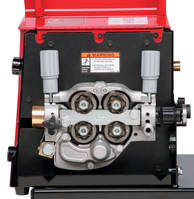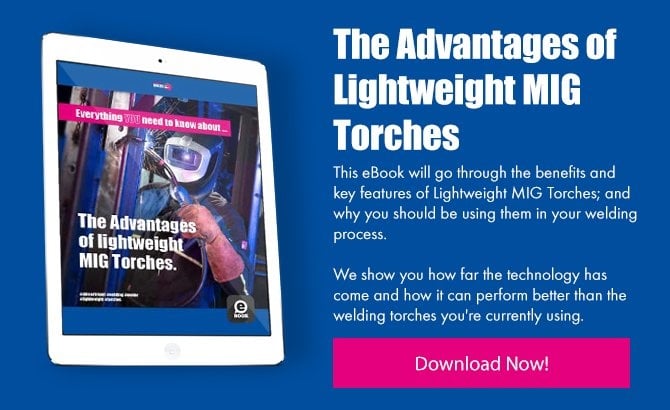When I visit welding facilities around the country I get to see the ins and outs of many different welding processes, including the treatment, handling, and safety of their MIG guns and their general weld technique. I’ve seen both ends of the spectrum, good and bad.
Some of the bad techniques and practices observed every day are so easily fixable with just a couple tweaks to standard operating procedures, improved technique, or habits.
So, what are some of these worst MIG welding practices?
Incorrect, or Inadequate MIG Gun Safety Practices
A lot of MIG guns are durable and can withstand day-to-day use, but they can still become damaged; sometimes without you even knowing. It is a good practice to perform routine maintenance, and inspect all of your welding equipment before you start work for the day. You’re looking for exposed wires, damaged cables, loose consumables, cracked handles, or anything that affects the integrity of the gun. If a torch is damaged it could short out. Additionally, a damaged MIG gun could produce fewer desirable welds or not work altogether. Some welders use duct tape or electrical tape over a damaged cable to prolong its life, but that is only a band aid and poses a serious safety risk if not properly fixed or replaced.
-Jan-16-2025-08-51-51-5261-PM.png?width=299&height=299&name=Untitled%20design%20(1)-Jan-16-2025-08-51-51-5261-PM.png) Welding is dangerous work. Without the proper safety equipment, you could do serious damage to yourself or others. To fully protect yourself from the harmful UV rays and spatter that come from the weld, you must wear the correctly shaded welding helmet/hood, as well as gloves, a welding jacket (preferably a jacket that covers your neck), and steel-toed boots. On top of that, having welding screens/curtains surrounding the work area prevents anyone walking by being affected by the UV rays. In my time as a welder I’ve had plenty of times where spatter has gotten into a place it shouldn’t be, but because I was wearing the proper equipment, I was mostly unharmed.
Welding is dangerous work. Without the proper safety equipment, you could do serious damage to yourself or others. To fully protect yourself from the harmful UV rays and spatter that come from the weld, you must wear the correctly shaded welding helmet/hood, as well as gloves, a welding jacket (preferably a jacket that covers your neck), and steel-toed boots. On top of that, having welding screens/curtains surrounding the work area prevents anyone walking by being affected by the UV rays. In my time as a welder I’ve had plenty of times where spatter has gotten into a place it shouldn’t be, but because I was wearing the proper equipment, I was mostly unharmed.
Welding fumes also need to be taken into consideration. All forms of welding – no matter the wire, gas, or base material used - produce smoke/fumes that can be extremely harmful with prolonged exposure. Using a fresh air hood, fume extraction system, or even a simple mask can protect you. I’ve seen plenty of people welding with smoke going up into their hood, and they’re breathing in those harmful fumes whether they can or can’t feel or see it.
Being aware of your work area, taking precautions, and wearing the correct gear will keep you safe, but understanding the equipment you use increases your odds of doing the job right.
Understanding Welding Equipment Against Your Process
Being unfamiliar with your equipment can easily lead to bad results. Study the processes that you have and make sure that the equipment you are using is right for the job. There have been many times that I’ve seen a welder use a high amperage MIG gun on a low amperage job, like a 450 Amp gun on sheet metal. This causes unnecessary stress on the welder’s body from carrying a heavier torch. This goes the same for using a torch that is not rated right for your process. The torch will overheat and become unusable – think like a 400 Amp MIG gun on thick metal plate. Some welding machine manufacturers will send a torch with their machine as a package. You just have to be aware that it might not be the right torch for your process.
Probably the most common torch practice that I run into is using the wrong contact tip for the size wire in your process (.045” wire with a .052” contact tip). The concept of using an oversized contact tip is that it will last longer as a result. This is incorrect. The purpose of a contact tip is to transfer current; when using an oversized contact tip, the wire is coming in contact with the tip much less, reducing the amount of current transferring to the weld.
As well as proper sizing, be mindful of the material that your contact tip is made of. For example, a copper contact tip may weld just fine in an automated process, but are you getting your money's worth? Using a silver-plated contact tip could drastically increase the lifetime of your contact tips, meaning fewer tip changes, and reduced downtime. On the other side, you may be using a tip that is more than you need. For manual MIG guns at lower amperages, a copper or copper zirconium contact tip will work just as well, last just as long, and is much less cost than a silver-plated tip. Check over your process and find the size/material contact tip that fits, and is the most cost-effective option for you.
With wire liners, it’s the same story. I’ve seen shops try to save money by purchasing a liner that would “fit” a small range of different sized wires (.052” liner for .035”- .052” wire). Using an oversized liner can result in the wire bird nesting, micro-arcing, and wire feed issues; potentially damaging the entire torch. As with contact tips, the material is also a factor when selecting the proper wire liner. Using a steel wire liner in a stainless steel process could lead to contamination of the weld puddle. This can happen when the stainless-steel wire comes in contact with the liner and picks up trace amounts of steel.
It is very important to choose a wire liner that is specific to your process. There are several varieties that are correct for whatever base metal or wire you are welding with.
 Having the correct drive rolls on your wire feeder is also important. You base this off of the type of wire you are using. There are a few different types of drive rolls; v-groove, knurled, and u-groove. Double check what the wire type you are using calls for. For example, flux-core and metal-core wires generally use knurled drive rolls to grip the wire and push it through. You don’t want the drive roll tension to be too high because it could affect the shape of the wire, creating a snowball effect that destroys your wire liner and other consumables.
Having the correct drive rolls on your wire feeder is also important. You base this off of the type of wire you are using. There are a few different types of drive rolls; v-groove, knurled, and u-groove. Double check what the wire type you are using calls for. For example, flux-core and metal-core wires generally use knurled drive rolls to grip the wire and push it through. You don’t want the drive roll tension to be too high because it could affect the shape of the wire, creating a snowball effect that destroys your wire liner and other consumables.
Another common practice I see is using the wrong welding gun nozzle. It could be recessed too much or too little depending on your process. The industry standard for recessed welding nozzles is a 1/8” recess. Some applications, manual or automated, call for a flush or stick out nozzle, but a 1/8” recessed nozzle will work for most MIG gun welding applications.
Poor Welding Techniques During Setup, Maintenance, and Operation
Following all of the safety practices and using the correct equipment is very important to a healthy, productive welding environment, but just as important are the techniques that welders use every day.
Duty cycle dictates how long a torch can weld within a ten minute period. Most air-cooled MIG guns are rated at 60% duty cycle, meaning that you can weld six out of ten minutes. A best practice is to not push your torch to its upper limit if you don’t need to. A lot of shops I see are welding at around a 30-40% duty cycle because there is time for material handling, fit up, measuring, and inter-pass or inter-weld cleaning, but it does depend on the needs of your process. Not following the specified duty cycle will lead to the torch overheating and breaking down over time; it could also heat the torch up to the point where it could potentially burn the welder. If you have a process that requires welding for long periods of time, a 100% duty cycle, water-cooled MIG gun might be the option for you.
A very common one I see is an improperly cut wire liner. Besides making sure that you don’t damage the liner when cutting it, making sure it’s the right length is crucial. If the wire liner doesn’t make full contact with the contact tip, micro arcing may occur, potentially damaging the entire torch from overheating. A lot of people assume that when you get a new torch, and have to replace the liner for the first time and that you can cut the new liner to the same length as the one you are replacing. This may work some of the time, but cable lengths aren’t exact. There are tolerances – small ones, but they vary enough; sometimes up to 1/2”. You should measure a new liner every time before cutting. A good practice is to cut the liner a few millimeters longer than you need, so that when you thread your contact tip it will make full contact and compress the liner.
Something as simple as measuring the torch distance from the work piece in a robotic welding process goes unchecked sometimes. This can potentially ruin an entire work piece due to a poorly executed weld. An easy way to stay consistent with torch distance is to create a jig to use as your reference point. Measure the distance, transfer that distance to a piece of flat bar or something non-metallic and mark it. Now you can use that piece as a quick reference of how far the torch is from the work piece without having to measure it out each time.
Improper tooling can mean premature failure of consumables and other MIG gun components. You should always use the manufacturer specified tool for every part; whether it be a diffuser or a contact tip. Welders will sometimes use vice grips or channel locks to remove them, that can cause warping of the consumables and make them unusable. In addition, you should always make sure that your consumables are completely tightened – not just hand spun. If loose, they can overheat from micro arcing and wear prematurely.
Quick Tip: You can tell if a contact tip was loose during welding if it has inconsistent discoloration on its threads.
Lastly, one I see very frequently is welders dragging their nozzle along the work piece while they weld. This is a very bad habit to have because it can significantly decrease the life of your nozzle. Not only that, but as the nozzle wears down the protective insulation will wear down with it. Without the insulation the nozzle could transfer current and cause a short when the nozzle comes in contact with the work piece. An alternative practice is making sure you are in a comfortable welding position, so that you aren’t relying on your torch to take stress off of your body.
Some of the Better MIG Welding Practices I See
Welders that plan every weld takes several things into account, like accessibility, and heat distortion. In some cases, the welds need to be made in a certain sequence to reduce distortion or maintain accessibility. By planning ahead and visualizing the weld and sequence you will gain efficiency and produce quality welds. Think of planning a weld like you would planning a road trip. You plan your turns to arrive at your destination, and typically don’t get surprised.
Another good practice is having the actual part drawings close by for reference. Drawings are the map that you are following to manufacture your final product or assembly. With that drawing, your Weld Procedure Specification (WPS) is also good to keep close by and in some cases required.
Many welders have some spare parts nearby that can easily be changed out if needed, but with these spare parts, a very good practice is to inspect the MIG gun and its components at the start of a shift, or even before a long weld (having a parts diagram for the torch is a good habit as well). The last thing you want is to be partly through a weld, particularly a highly inspected weld that may be looked at by ultrasonic weld inspection (x-ray) and have to stop, replace parts or do a parts cleaning, then get back to welding after prepping to start a new weld. This can pose an issue with the integrity of the weld and possibly having to re-work it or scrap the parts. Definitely not worth taking the short cut of not doing a quick MIG gun and consumable inspection.
Oftentimes, I work with customers that have an established preventative maintenance or inspection plan in place for their welding equipment. This is not limited to both manual and automated welding guns. By having a maintenance schedule in place and replacing worn or damaged parts, you ensure the longevity and reliability of the equipment.
The goal for your welding operation should be a safe, productive, and efficient work space that uses the right practices to get the most benefit from your parts and equipment. Don’t just settle for the way you’ve always been doing it. It’s likely if you take a hard look at how your welding operation or even your weld station (if you’re a welder) is performing on a day to day basis you’ll see several areas where just a few small tweaks can lead to huge improvements in comfort, cost reduction, time savings, and productivity.
A great resource to start is the American Welding Society (AWS). They specify procedures and techniques for the entire world of welding.
For your equipment, talk to your OEM rep or your welding supply rep. Ask them to take a fresh set of eyes on your shop floor and see if they notice anything they think you could do to get more out of your production. Chances are they’ll have a few recommendations to try, and you’ll be better off long term for testing something that could lead to big gains.


